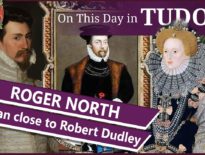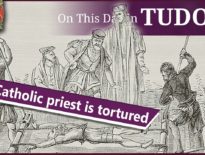On this day in Tudor history, 2nd December 1586, following a joint petition from the Houses of Lords and Commons, Elizabeth I finally agreed to a public proclamation of sentence against Mary, Queen of Scots: death.
Mary had been found guilty of high treason back in October 1586, but Elizabeth had not wanted to contemplate regicide. However, Parliament believed that if Mary, Queen of Scots, was not executed, that she'd continue to plot against Elizabeth and would utterly "ruinate and overthrow the happy State and Common Weal of this most Noble Realm". She was too much of a danger and needed dealing with once and for all.
Find out what Parliament said and what happened next in today's talk.
And here is the video I mention on Amias Paulet, the man Elizabeth I wanted to murder Mary, Queen of Scots:
Also on this day in Tudor history, 2nd December 1546, Henry Howard, Earl of Surrey, poet, courtier, soldier and the eldest son of Thomas Howard, 3rd Duke of Norfolk, was arrested after a former friend gave evidence against him. King Henry VIII had just weeks to live and was increasingly paranoid, so the 'evidence' was just what Surrey's enemies needed to bring the earl down.
Find out more about the Earl of Surrey's downfall, and how his father managed to keep his head in last year’s video:
Also on this day in Tudor history:
- 1560 – Death of Charles de Marillac, French diplomat and Archbishop of Vienne, at Melun in France. Marillac was a resident ambassador at the court of Henry VIII from 1538 to 1543 and described Henry VIII as having three vices, which he described as “plagues”: “the first is that he is so covetous that all the riches of the world would not satisfy him. Thence proceeds the second, distrust and fear. This King, knowing how many changes he has made, and what tragedies and scandals he has created, would fain keep in favour with everybody, but does not trust a single man, expecting to see them all offended, and he will not cease to dip his hand in blood as long as he doubts his people. The third vice lightness and inconstancy.”
Marillac was banished from the French court in 1560 after opposing the policies put forward by the Guises at the Assembly of Notables at Fontainebleau. - 1615 – Burial of Edward Wright, mathematician and cartographer, at St Dionis Backchurch, London. He died in late November 1615, while working on his book “A Description of the Admirable Table of Logarithmes”. Wright is known for his work on the mathematics of navigation and his 1599 treatise “Certaine Errors of Navigation”, which explained and developed the Mercator projection.
Transcript:
On this day in Tudor history, 2nd December 1586, Parliament met following their request for Elizabeth I to sanction the execution of Mary, Queen of Scots, and the commissioners' meeting in the Star Chamber where they condemned her to death. A draft proclamation of sentence, written by Elizabeth and her chief advisor, William Cecil, Lord Burghley, was published at the Parliament, and this was followed by the drafting of an execution warrant by Sir Francis Walsingham.
Mary, Queen of Scots, had been tried for treason at a trial that opened at Fotheringhay Castle on 14th October 1586. The Crown had provided evidence that not only did Mary know about the Babington Plot, a plot to assassinate Elizabeth and to replace her with Mary, she had given it her approval, writing in a letter to Babington. Mary had proclaimed her innocence, saying “I would never make shipwreck of my soul by conspiring the destruction of my dearest sister”, but after Babington had written to her of the plot, writing that six men, his “private friends”, would be in charge of “that tragical execution”, referring to the dispatch of Elizabeth, Mary had replied “then shall it be time to set the gentlemen to work taking order upon the accomplishing of their design”. Mary tried to argue that she hadn’t specified what that “work” was, but it was no good. Although sentencing was delayed somewhat, she was found guilty on 25th October.
On 29th October 1586. the sixth Parliament of Elizabeth I’s reign opened. The queen refused to attend the state opening as the reason for this Parliament was to discuss the Mary, Queen of Scots issue. Mary had been found guilty of treason, but she was an anointed queen, albeit one that had been forced to abdicate, and so there were questions regarding the legality of executing her. Elizabeth really didn’t want to commit regicide, but her privy council wanted Mary gone for good. The History of Parliament website, which is a wonderful source, explains how privy councillors Sir Christopher Hatton, Sir Walter Mildmay, Sir Ralph Sadler and John Wolley all gave speeches to the the Commons in the opening days in support of Mary’s execution.
On 5th November, Elizabeth’s Lord Chancellor, Sir Thomas Bromley addressed the Lords, declaring “ the foul and indirect dealings practised by the Queen of Scots against her Majesty and the whole Realm, notwithstanding so many great benefits and favours which the said Queen of Scots had received of her Majesty”, and on 9th November, “diverse” letters, including ones written by Anthony Babington and Mary were read out, as was the sentence pronounced by the commission that had tried Mary.
After both houses had deliberated, a joint petition from the Lords and Commons calling for Mary’s execution was delivered to Elizabeth on 12th November. In it, they described their grief over the “most dangerous and execrable practices” of Mary, Queen of Scots”, who had “compassed the destruction of your Majesties sacred and most Royal Person” and wanted “utterly to ruinate and overthrow the happy State and Common Weal of this most Noble Realm”. They explained how they had carefully considered the proceedings against Mary and that they believed that if she did not receive “due punishment which by Justice and the Laws of this your Realm she hath so often and so many ways for her most wicked and detestable offences deserved” then Elizabeth “shall be exposed unto many more and those more secret and dangerous Conspiracies than before”.
They concluded by writing:
“We do most humbly beseech your most Excellent Majesty, that as well in respect of the continuance of the true Religion now professed amongst us, and of the safety of your most Royal Person and Estate, as in regard of the preservation and defence of us your most loving, dutiful and faithful Subjects, and the whole Common-Weal of this Realm, It may please your Highness to take speedy Order, That Declaration of the same Sentence and Judgment be made and published by Proclamation, and that thereupon direction be given for further proceedings against the said Scottish Queen according to the effect and true meaning of the said Statute : Because upon advised and great consultation we cannot find that there is any possible means to provide for your Majesties Safety, but by the just and speedy Execution of the said Queen, the neglecting whereof may procure the heavy displeasure and punishment of Almighty God, as by sundry severe Examples of his great Justice in that behalf left us in the Sacred Scriptures doth appear. And if the same be not put in present Execution, We your most loving and dutiful Subjects shall thereby (so far as mans reason can reach) be brought into utter despair of the continuance amongst us of the true Religion of Almighty God, and of your Majesties Life, and the Safety of all your faithful Subjects, and the good Estate of this most flourishing Common-Weal.”
However, the queen wouldn’t give a definitive answer, and just kept stalling, saying that “it was a Cause of great moment, and required good deliberation, and that she could not presently give Answer unto them. It wasn’t until this day in history, 2nd December 1586, the final day of the Parliament, that she finally agreed to their petition and allowed Mary’s death sentence to be proclaimed.
On the 4th December, Mary was publicly proclaimed guilty and the citizens of London celebrated by lighting bonfires.
But Elizabeth still stalled. As I explained in my talk from 26th September, which I’ll give you a link to, what she really wanted was for Mary’s fate to be taken out of her hands and for a private citizen to act under the Bond of Association and assassinate Mary, a man like Mary’s gaoler, Sir Amyas Paulet. But Paulet would not do it.
Elizabeth finally signed Mary’s death warrant on 1st February 1587, although she gave orders for it not to be sent on to Fotheringhay, hoping against hope that Paulet would kill Mary, but Elizabeth’s privy council sent it and on 8th February 1587 Mary was beheaded. Elizabeth’s advisors must have breathed a sigh of relief at news of the execution, but then they faced their queen’s wrath!



Leave a Reply